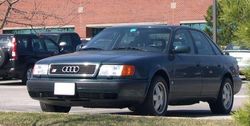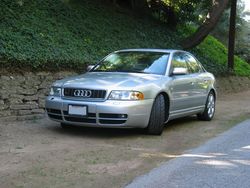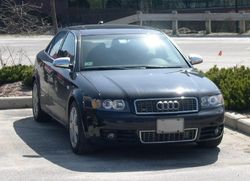.
Audi S4: Difference between revisions
| Line 39: | Line 39: | ||
Interestingly enough, German tuner Abt Sportsline decided to forego the V8 and use a modified version of the 3.2 [[V6|V6]] FSI engine in a special high-performance B7 S4 it created, named Abt AS4-R. This car now has a 480 PS (353 kW/473 [[HP|hp]]) engine, and can reach a maximum speed of 300 km/h (186 mph), surpassing 100 km/h in 4.6 seconds. Changes to chassis include a stiffer adjustable suspension, with new stabilizers, 19 inch wheels and Dunlop SP Sportmaxx tyres. | Interestingly enough, German tuner Abt Sportsline decided to forego the V8 and use a modified version of the 3.2 [[V6|V6]] FSI engine in a special high-performance B7 S4 it created, named Abt AS4-R. This car now has a 480 PS (353 kW/473 [[HP|hp]]) engine, and can reach a maximum speed of 300 km/h (186 mph), surpassing 100 km/h in 4.6 seconds. Changes to chassis include a stiffer adjustable suspension, with new stabilizers, 19 inch wheels and Dunlop SP Sportmaxx tyres. | ||
==General References== | ==General References== | ||
Revision as of 20:00, 13 July 2006
The Audi S4 is a high performance sport version of the popular Audi A4.
First generation (1991-1994)
Audi was re-configuring its lineup during the early 1990s, and introduced the S4 in 1991 as the performance version of the re-styled 100 sedan. Despite sharing its basic structure with the 100, the S4 effectively took the place of the 200 Turbo-Quattro sedan, which had been discontinued the year before.
The S4 was sold worldwide with a turbocharged version of Audi's 2.2 L (2226 cc), 20-valve inline-5 engine developing 230 PS (227 hp/169 kW) and 350 N·m (258 |ft·lbf) of torque. A 280 PS (276 hp/206 kW) 4.2 V8 became available to European customers as an option. Quattro all-wheel-drive and a manual transmission (six-speed in Europe, five-speed in North America) were standard equipment.
After Audi dropped the 100 nameplate and re-badged the car as A6 in 1994, the S4 became the S6, although the only real changes to the model were minor cosmetic updates and the addition of a more powerful S6 Plus model to the lineup. After the first generation A6 was replaced in 1998 by an updated version, the S4 and S6 became distinctly separate from one another.
Being the first in the S4 lineup, it is commonly referred to as the UrS4.
Second generation (1997-2002)
The second generation S4 debuted in 1997 as part of the B5 platform A4 line-up. Although the S4 was no longer available with a V8, its 2.7 L, twin-turbocharged V6 engine was more than adequate, producing 265 PS (195 kW/261 hp) in European trim. The engine was slightly detuned to meet US emissions regulations, and power stopped at 250 PS (184 kW/247 hp) in North America.
In addition to the sedan, a wagon version, the Audi S4 Avant, was introduced into the lineup from 1999.
The S4 could accelerate up to 100 km/h (62 mph) in a mere 5.6 seconds and had an electronically-limited top speed of 250 km/h (155 mph), making it both the quickest sedan in the Audi model line and among the quickest sedans in the world at that time. As in the previous S4, a six-speed manual transmission was standard equipment, as was the quattro all-wheel-drive. A five-speed Tiptronic transmission became available for the first time as an option. Production ceased on the B5 S4 in 2001.
The B5 S4 has a devoted enthusiast community that focuses on attaining supercar-level power and performance. Currently, the B5 S4 is considered the most potentially powerful of the S4 lineup. Being a turbocharged car, it can gain significant power by simply upgrading the engine management software. By replacing the K03 turbos with the larger RS4's K04 turbos, aftermarket and home tuners can easily increase power to the 450 hp (335 kW) range.
Third generation (2003-2005)
The third generation, B6 platform S4 debuted in mid-2003. Despite having moved to yet another entirely new platform, the S4's most publicized new feature was its engine. It became available in three bodystyles for the 2004 model year: the S4 sedan, the S4 Avant wagon and a convertible, the Audi S4 Cabriolet.
Replacing the 2.7 L twin-turbocharged V6 engine of the previous generation S4 was a 4.2 L, 40-valve V8 based on the unit from the A8 and producing 344 PS (253 kW/340 hp), making it more potent than either the S6 Plus or RS2 and nearly as powerful as the B5 platform RS4.
With such abundant power on tap, the B6 S4 could accelerate quickly enough to meet or beat the times of most sports cars. Road tests conducted by American automotive magazines indicated that it could go from a standstill to 100 km/h in 5.2 seconds, and make it to 200 km/h (124 mph) in slightly over 20 seconds.
Like its predecessors, the model was standard with a six-speed manual and Quattro, the Tiptronic transmission remained an option. The B6 platform S4 was replaced by the B7 platform S4 in late-2005.
Fourth generation (2005- )
The B7 platform S4 is the most recent version of the vehicle, having debuted in late 2005. Although Audi classifies it as a new car, the differences between it and the outgoing B6 S4 are primarily cosmetic.
Audi has, however, made a few notable changes, including adding new springs and dampers to the suspension and re-calibrating the quattro system to maintain a 40:60 front-to-rear torque split under normal conditions. The system is continuously adjustable though, and the torque split can change depending on driving conditions. The new "fish mouth" grill, narrow headlamps, "L" tail-lamps and quad exhaust tips help distinquish the B7 from the previous B6 model.
Interestingly enough, German tuner Abt Sportsline decided to forego the V8 and use a modified version of the 3.2 V6 FSI engine in a special high-performance B7 S4 it created, named Abt AS4-R. This car now has a 480 PS (353 kW/473 hp) engine, and can reach a maximum speed of 300 km/h (186 mph), surpassing 100 km/h in 4.6 seconds. Changes to chassis include a stiffer adjustable suspension, with new stabilizers, 19 inch wheels and Dunlop SP Sportmaxx tyres.
General References
- {{#if:Stephen L. Thompson
|{{#if:
|[[{{{authorlink}}}|{{#if:
|{{{last}}}{{#if:
|, {{{first}}}
}}
|Stephen L. Thompson
}}]]
|{{#if:
|{{{last}}}{{#if:
|, {{{first}}}
}}
|Stephen L. Thompson
}}
}}
}}{{#if:Stephen L. Thompson
|{{#if:
|, {{{coauthors}}}
}}
}}{{#if:
| ({{{date}}})
|{{#if:
|{{#if:
| ({{{month}}} {{{year}}})
| ({{{year}}})
}}
}}
}}{{#if:Stephen L. Thompson
|.
}}{{#if:
|[{{{url}}}
|
}} {{#if: |“|"}}Preview: Audi S4{{#if: |”|"}}{{#if:
|] |
}}{{#if:
| ({{{format}}})
}}{{#if:Car and Driver
|. Car and Driver
}}{{#if:
| {{{volume}}}
}}{{#if:March 1992
| (March 1992)
}}{{#if:79–80
|: 79–80
}}{{#if:
| . DOI:{{{doi}}}
}}{{#if:
|. {{{id}}}
}}{{#if:
|. Retrieved on [[{{{accessdate}}}]]
}}.
- {{#if:Arthur St. Antoine
|{{#if:
|[[{{{authorlink}}}|{{#if:
|{{{last}}}{{#if:
|, {{{first}}}
}}
|Arthur St. Antoine
}}]]
|{{#if:
|{{{last}}}{{#if:
|, {{{first}}}
}}
|Arthur St. Antoine
}}
}}
}}{{#if:Arthur St. Antoine
|{{#if:
|, {{{coauthors}}}
}}
}}{{#if:
| ({{{date}}})
|{{#if:
|{{#if:
| ({{{month}}} {{{year}}})
| ({{{year}}})
}}
}}
}}{{#if:Arthur St. Antoine
|.
}}{{#if:
|[{{{url}}}
|
}} {{#if: |“|"}}Magnum Force{{#if: |”|"}}{{#if:
|] |
}}{{#if:
| ({{{format}}})
}}{{#if:Car and Driver
|. Car and Driver
}}{{#if:
| {{{volume}}}
}}{{#if:April 1992
| (April 1992)
}}{{#if:47–56
|: 47–56
}}{{#if:
| . DOI:{{{doi}}}
}}{{#if:
|. {{{id}}}
}}{{#if:
|. Retrieved on [[{{{accessdate}}}]]
}}.



